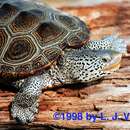en
names in breadcrumbs


As part of the most successful family of Chelonians, the genus Malaclemys includes a single species with seven subspecies, six of which are distributed in the salt and brackish waters from New England to Texas and possibly Mexico. The closest relatives are probably the genus Graptemys. They both have almost no apparent fossil record. The differing characteristics of the two genera are the dark head markings on a light background in Malaclemys and light stripes on a darker background for Graptemys (Alderton 1988).
In the past, Malaclemys sp. were often considered a delicacy because of the sweet meat. These turtles were almost brought to extinction in the early years of the present century. They were either relentlessly hunted for their flesh or died of drowning in underwater crab traps. The group suffered worse than the snapping turtles of family Chelydridae, but has since recovered in numbers (Dixon 1987).
Currently, seaside development has led to the loss of nesting beaches. Tire tracks from vehicles used on the sand pose a hazard to hatchlings. The tiny turtles get trapped in the tire tracks and die of dehydration before reaching water.
To prevent extinction, however, diamondbacks are protected in several states. Interestingly, in some places the native beachgrass is now also protected and removal is against the law. Researchers have found that the presence of the beachgrass lowers the temperature of the nesting areas and can affect the sex of the hatchlings. The terrapin populations were also revived by activists who consider the gentle creature a good pet (Loutrel and Cornett 1993).
US Federal List: no special status
IUCN Red List of Threatened Species: lower risk - near threatened
Malaclemys terrapin eat snails, other mollusks, crustaceans, fish, insects, and carrion (Bartlett and Bartlett 1999). They use the ridges in their jaw to crush their prey. Therefore, M. terrapin will only eat the soft-shelled mollusks and crustaceans (Tucker, et al 1997).
Malaclemys terrapin occurs along parts of the eastern coast of the United States from as far north as Cape Cod, Massachusetts, to the southernmost Florida Keys. The turtles are also abundant in the Gulf Coast, from Florida to Texas. (Loutrell and Cornett 1993).
Biogeographic Regions: nearctic (Native ); atlantic ocean (Native )
Diamondback terrapins inhabit saltwater habitats, including brackish channels, lagoons, tidal flats, marshes, estuarine areas, and coastlines. They particularly favor reedy marshes, and while they live near saltwater, they require fresh water for drinking purposes (Garrett and Baike 1987).
Aquatic Biomes: coastal
A grayish to nearly black carapace usually has spots or streaks of black on gray skin, making Malaclemys terrapin one of the darkest turtle species. The species is also distinguished from the other species by a tuberculate, or a knobbed keel; a higher shell with deeper bridge; a deeper gular notch; a consistently white upper lip; and a uniformly colored carapace and plastron (Alderton 1988). The skull has a long, bony temporal arch. The hind legs are relatively large and the toes are webbed beyond the bases of the nails. This species is known to have the greatest sexually dimorphic size disparity found in any North American turtle. Males are usually smaller in both body and head size, while the females are large. Females often attain carapace length of 9 inches, while males usually reach a maximum of 5.5 inches. Malaclemys terrapin is the only diamondback terrapin to occur in Texas (Carr 1952).
Other Physical Features: ectothermic ; bilateral symmetry
Average mass: 720 g.
Average basal metabolic rate: 0.140702 W.
While all turtles reproduce by eggs, the genus Malaclemys usually does not produce more than 4-8 eggs in a clutch. Females typically nest several times annually. The duration of incubation varies between 60 and 85 days, depending on soil temperature and nest depth. During April and May, the female digs a nest cavity 4-8 inches deep in sand. The oval eggs are 1 * inches long, pinkish-white, and covered with leathery shells.
Wild hatchlings may spend their first years upstream in creeks. These creeks may either be brackish or relatively fresh water. As the hatchlings age, they move down to the salty marshes where nutrients and good nesting sites are plentiful. Hatchlings are 1 to 1.5 inches long and are known to be able to produce eggs for several years after a single mating. Females reach sexual maturity in approximately 7 years and males a little earlier. Interestingly, the sex ratio appears to favor females. In a sample of 1,433 individuals, females outnumbered males nearly six to one (Alderton 1988).
Key Reproductive Features: gonochoric/gonochoristic/dioecious (sexes separate)
Average gestation period: 84 days.
Average number of offspring: 9.
Average age at sexual or reproductive maturity (male)
Sex: male: 910 days.
Average age at sexual or reproductive maturity (female)
Sex: female: 2190 days.